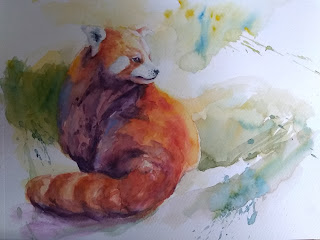Tate Modern Art Museum
 [Seated Figure, Francis Bacon, 1961]
[Seated Figure, Francis Bacon, 1961] [Summertime: Number 9A, Pollock, 1948]
[Summertime: Number 9A, Pollock, 1948]Under "Summer Time: Number 9A" (Jackson Pollock) quoted was "It wasn't until the 1970s that they detected a subtle form of order within the natural world, called fractal. Fractals consist of patterns that recur at finer and finer magnifications. A small part of the structure looks very much like the whole" (Physicist Richard Taylor)
--perhaps we may presume a systematic structure by looking the finest granularity of the ordinary.
 [Women and Bird in the Moonlight, Miró, 1949]
[Women and Bird in the Moonlight, Miró, 1949]Joan Miró's approach to sculpture: he collected insignificant objects such as pebbles or pieces of wood, then combined them with old tools, such as nails or broken bottles that he found by chance. He called this practice "the unlikely marriage of recognizable forms."
--unexpected yet well-suitable combination of things.
Arte Povera ("Poor Art"):Plistoletto, Boetti and Fabro.
This movement began in the early 1970s, using traditional materials such as greek marble, bronze, embroidery, etc. to address contemporary experience. They often outsourced fabrication. In other words, the artists' own touch was no longer central to their final work. For instance, (I think Fabro) a Venus statue stacked with old clothes.
http://www.tate.org.uk/modern/explore/


Comments